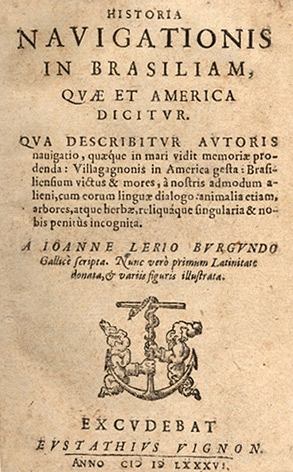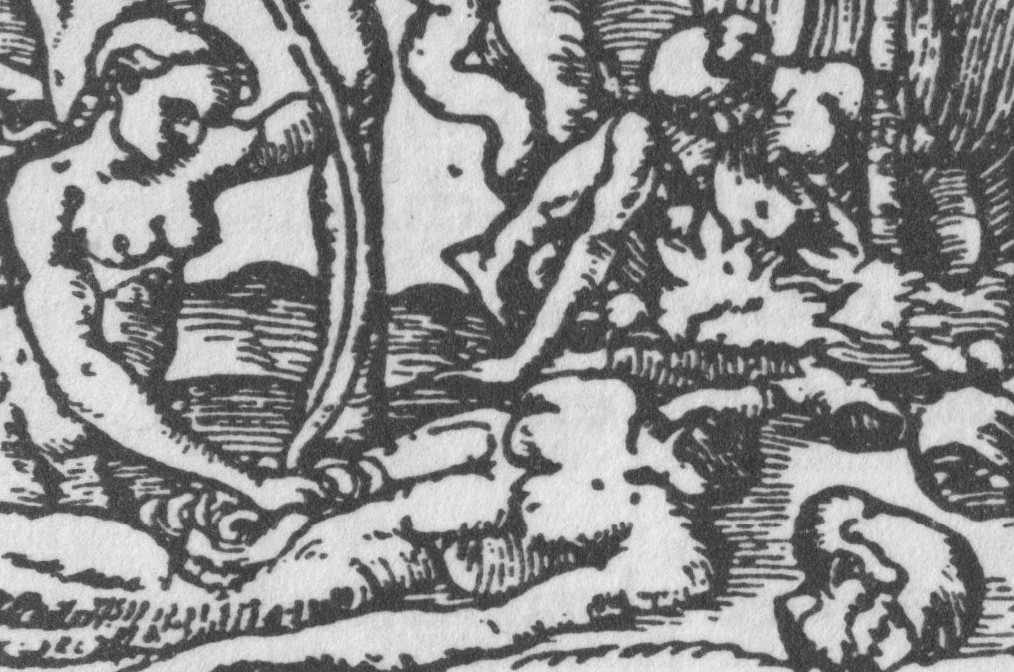
| Lingeblog Home |
| Previous |
| Next |
| Dutch |
Jean de Léry to Rio (but in 1556)

I found a new friend. His name is Jean de Léry. Let me say right away that he has a mental problem: he believes in God. Jean de Léry studied in Geneva with Calvin himself, and seems to be serious about the bible as the very word of God. As usual for such people, while securing himself in the dangers he meets, he leaves, with agility, fervour and good thinking, as little to his God as he possibly can, but every time he survives he loudly cedes all credits to Him, especially when the danger had been serious enough to inspire Jean's Eternal Master to retake quite some of his companions' souls. The rule seems to be: when your God is with you, you loudly profess your gratefulness, when against, you resign with an uncomprehending but open mind about any good intentions He may have had with His resolve.
But yes, despite this rather hopeless type of, for a possible friendship with adults normally fatal retardation of psychological development, I like him, and I will make clear why: though he joins the expedition to Rio, where the jungle still starts right at the beach, as a "missionary", it is clear from the start that his chief motivation is interest and curiosity. So, to Jean, there clearly is more to the world than the word of God. And this is emphatically at the centre of what he shares with me, the reader, in his travel report. It 'd better be too, since, as he is so honest to concede, neither he nor any of his Calvinist travel companions ever converted a single Indian. And he is not blaming them for it! All that makes me easily forgive him his God.
This guy is OK. And he undeniably has anthropological talents. And he can write. And, best of all, when describing the habits of the Indians, he rarely employs his Christian categories, nay, even regularly holds that the Indians are equal to, or should even be models to the masses of the sinful in his fatherland!
Would indeed the sinful Europeans lack the grounds to feel superior to the Indians? We do not hear of whites killing Indians, but they do kill each other. For instance, Protestants, Catholics and Heretic Protestants kill one another. So do French and Portuguese. For the Indians, killing enemies (and eating the prey) is the men's main social activity, just as the women's is taking care of the children and the household - including the roasting of the killed. Here the killing-target is not religiously defined. It consists of traditional enemies and their allies. So the Tuupinambaults, allied to the French, for instance, regularly attack and eat the Margajas and their allies, the Portuguese, while the Margajas retaliate in kind, and occasionally taste a Frenchman, though those were still rare on the scene.
These regular Indian wars, with the ritual killing, roasting and eating are not, Jean de Léry assures us, caused by competition for limited resources. All Indian tribes have much more land than they need to lead an abundant life. War is tradition, and ritual, de Léry has no doubt. And who could possibly doubt this when realizing that the Europeans over there also kill each other while there is enough for all of them too?
Jean de Léry does not write this himself, this is me, having learned from his writing in quite similar vein on many other occasions, even giving quite some examples of cannibalism among the native people of France. No European, Jean de Lévi is anxious to maintain, can derive any self-satisfaction from even the most repugnant of the habits of the Indians. He typically closes descriptions of questionable Indian habits by extensively referring to similar sins of the Europeans, thus carefully maintaining the discipline of his readers: if you are interested, then read me about the Indians, if you want to feel repelled, then look at yourself!

... Indian
woman preparing the meal...
Though it does not acquire a separate treatment of de Léry's astonishment, unlike other tropical people such as the African negroes at the time, the Indians had no knowledge of metallurgy beyond melting gold and silver. They were Stone Age people. But contrary to Sub-Saharan Africans until today these Indians knew how to use an arithmetic time line, counting moons. Up until today, the larger part of Sub-Saharan Africans works with a set of major events to order the minor ones along. Somebody's birth, for instance, is in Africa associated with, for instance, a serious famine. Hence normally older people in Africa can't properly tell you their numerical ages.
Not so the Indians and not only their counting was excellent. Their stone age techniques were surprisingly sophisticated. They did like the European mirrors, coombs, knives and fish hooks. The muzzle loading guns, however, that they immediately handled so professionally that some details of it got copied by the white, did not pass their tests as instruments of warfare: time between two shots was way too long. A closer approach of the enemy, and shooting arrows was correctly judged a far superior technique, especially since (wooden) arrows were of great quality and the Indians had trained themselves to shoot arrows with impressive speeds in a frequency reminding of machine guns.
Beware the Indians. Five centuries earlier, solidly Iron Age Vikings, the scare of Europe, landed on Newfoundland. In no time they were floating at sea again, with firm resolve to go back home.
Nevertheless, just a few years after the whites came in, the Indians sent some of their own on the white men's ships to France to learn metallurgy and production and handling of gun powder weapons, as we now know, underestimating the time they had to catch up.
______
In which I have endeavoured not to give away any of the spicy and entertaining details this instructive chronicle abounds with.